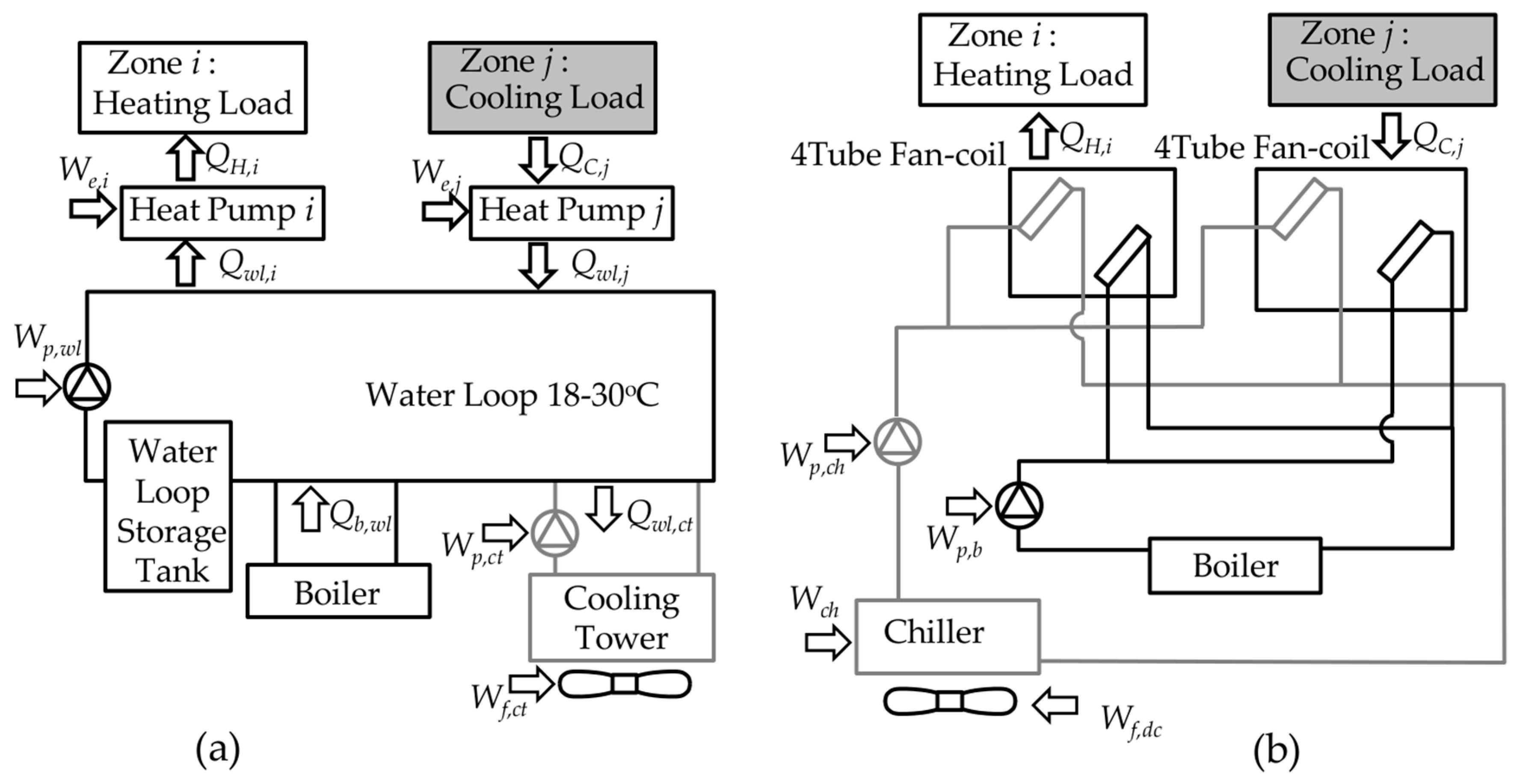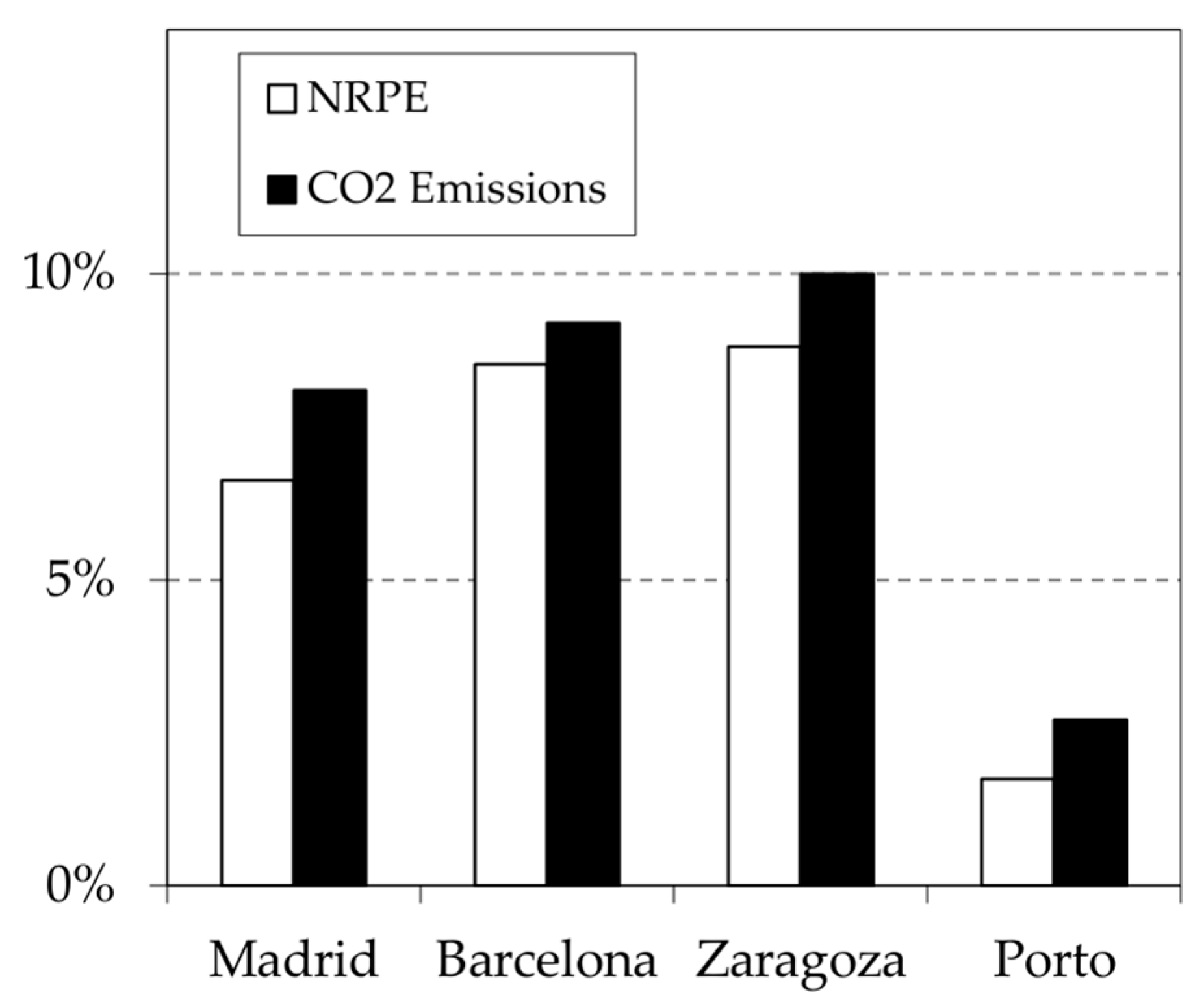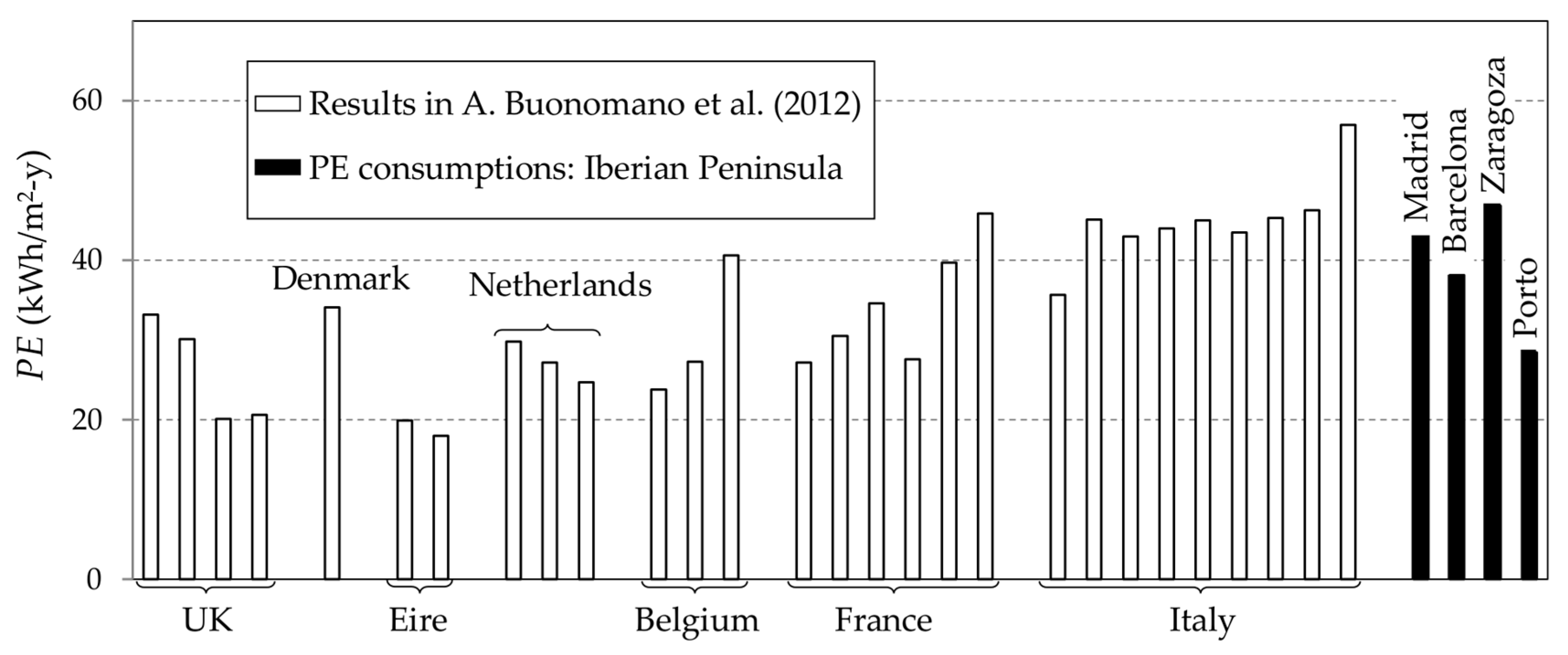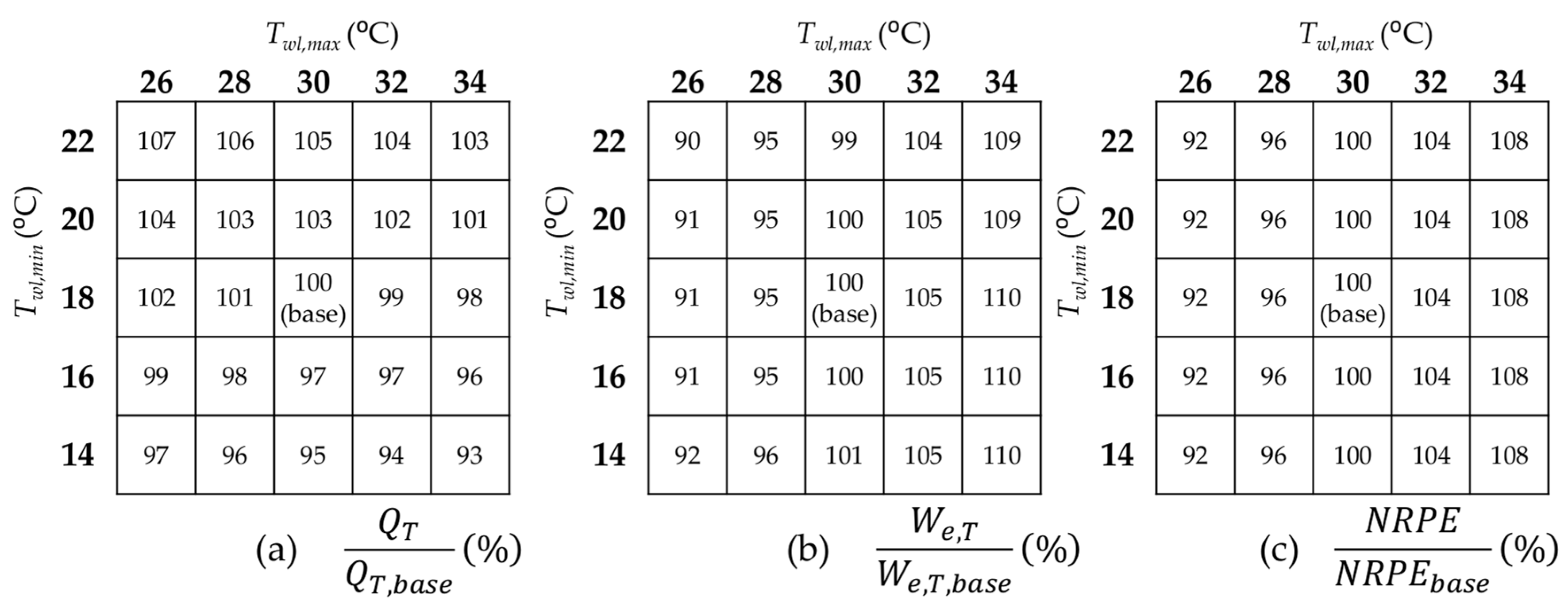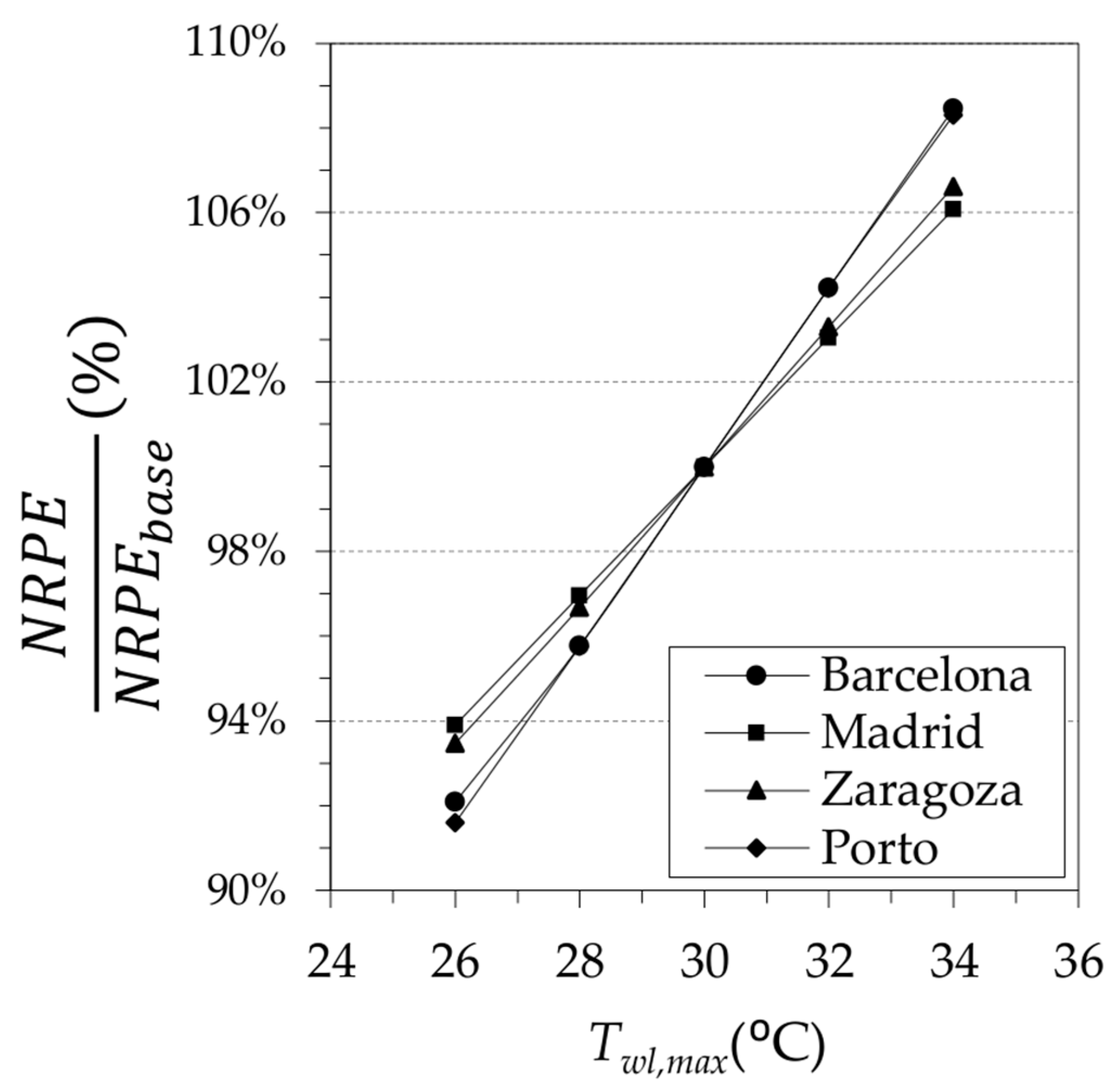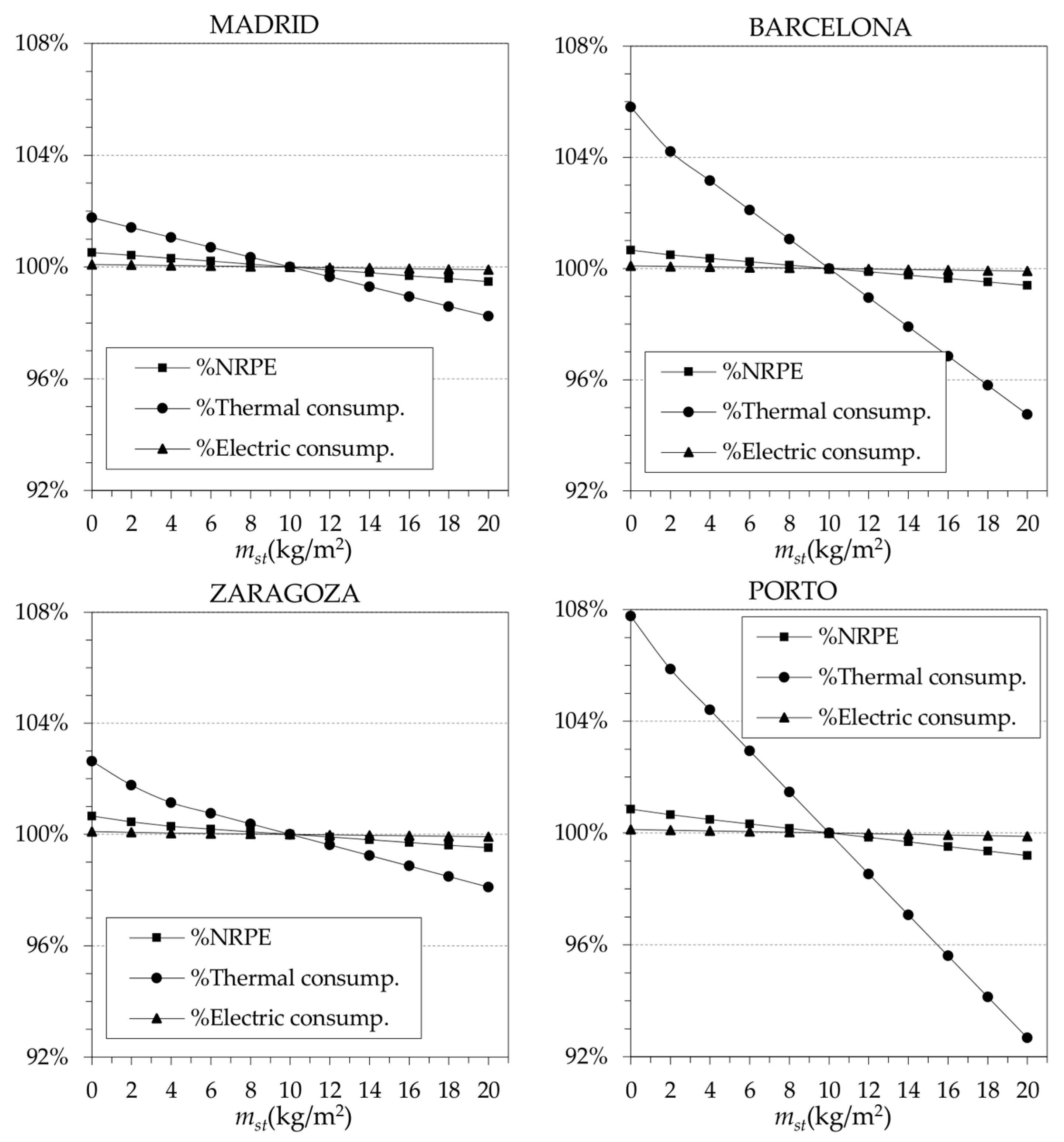1. Introduction
Water loop heat pump (WLHP) systems are common in the air conditioning of commercial and office buildings. In this scheme, one water loop circuit receives energy from condensation and yields it to evaporation in reversible heat pumps that address the thermal loads of different zones of the building. The net energy necessary to keep the water loop temperature in a proper range can be obtained from gas boilers or other energy production systems and dissipated by cooling towers. One important advantage of these systems is the transfer of energy between zones of the building when the system is simultaneously serving heating and cooling loads. Besides, heat pumps using the water loop as a source have very good efficiency as measured by the energy efficiency ratio (EER) in refrigeration and the coefficient of performance (COP) in heating mode.
Some references to WLHP systems can be found in specialized literature. Their performance has been analyzed in representative weather in China [
1] and in several European climatic areas [
2]. Yuan and Grabon [
3] optimized their working parameters by mathematical modeling. The effect of variable frequency-driven loop pumps was evaluated by Henderson et al. [
4] together with geothermal heat pump facilities. It is common for WLHP systems to be combined with geothermal in ground-source-water loop heat pump applications [
5,
6], and also with solar [
7] or other technologies like engine-driven heat pumps [
8] or CO
2 refrigeration units [
9].
The present study analyzed the behavior of a WLHP system in a common office building under typical climatic conditions in four important cities in the Iberian Peninsula. The energy consumption of this system and other more conventional systems were compared. The WLHP system is a water system with a four-tube connection design to allow simultaneous heating and cooling loads, fan-coils, one gas boiler and a conventional chiller. In the WLHP system, the boiler and the cooling tower keep the temperature of the water loop in a range, letting it freely oscillate while the temperature is inside this range. The effect of changing minimum and maximum temperature set points in this regulation system was studied, comparing annual consumption with a base case. The size of one thermal storage tank installed in the water loop was also studied as a design parameter. The objective was to obtain important information that could be useful to the optimization of the design of WLHP systems, reducing energy consumption for office building air conditioning.
2. Calculation of Energy Demands and Systems Energy Consumption
2.1. Energy Demand in an Office Building
A regular office building was studied in order to obtain the detailed energy demand profiles corresponding to four representative cities. The building had three occupied plants, as well as uninhabitable attic and ground floor zones. The gross total inhabited area was 918 m
2, and it had external zones with four orientations as well as an inner zone, as shown in
Figure 1a,b.
Typical compositions were chosen for the opaque surfaces, resulting in a U-factor values of 0.517 W/m
2-K for walls and 0.563 W/m
2-K for floors and ceilings. U-factor values were calculated by the procedure in the Ashrae Fundamentals Handbook [
10]. The U-factor for windows was 2.9 W/m
2-K and their solar heat gain coefficient was 0.72. Internal heat gains were included for people, lighting and office equipment: people activity was estimated at 130 W/person (p), with an occupation density of 12 m
2/p; the heat gain from lighting was fixed at 7 W/m
2; and internal heat gain for the electric office equipment was fixed at 8 W/m
2. The ventilation air volume was fixed at 12 l/s-p. These are the maximum values for people, lighting, equipment and ventilation loads. Their profiles follow the occupation schedule in
Figure 1c. Constant air infiltration values were fixed for uninhabitable zones: 2 air changes per hour in the attic and 3 changes per hour on the ground floor. The loads were calculated for an ideal air loads mode, with cooling and heating thermostat schedules that would keep the air temperature in a range between 21 °C and 25 °C during working hours from Monday to Friday, and humidity controls which would keep humidity ratios between 45% and 55% for the same schedule.
The calculations of the energy demand were performed with the EnergyPlus [
11] simulation software, using the OpenStudio
® [
12] platform to define the building, loads and weather data. The energy demand was calculated for the typical climatic conditions of four cities in the Iberian Peninsula: Madrid, Barcelona, Zaragoza and Porto. The weather data files were obtained from the EnergyPlus site, using weather data from the Spanish Weather for Energy Calculations (SWEC) database for Spanish cities and from the International Weather for Energy Calculations (IWEC) database for the Porto weather data.
2.2. Heating, Ventalation and Air Conditioning (HVAC) Systems
The energy consumption necessary to fulfill the building’s energy demands were compared for a WLHP system and a conventional 4-tube fan-coil water HVAC system.
Figure 2 shows two simplified configuration schemes for these systems. One storage tank is included in the water loop system.
2.3. Energy Calculations in the WLHP System
The energy consumption in the WLHP system, represented in
Figure 2a, was estimated by Equations (1)–(11). The calculations were performed in terms of energy analysis in time step periods Δ
t of one hour. For each time step period, the net thermal energy from heat pumps to the water loop was calculated from the heating and cooling demands, with regards to the cooling energy efficiency ratio and the heating coefficient of performance of the heat pumps:
The COP and the EER were estimated with Equations (2) and (3) through the Carnot limit values with an approximation factor
ξC = 0.5. The condensation and evaporation temperatures for the Carnot limit calculation were related to ambient temperatures and their difference from the water loop temperature,
Twl.
When the net thermal energy to the water loop was positive due to higher condensing heat from the heat pumps, this energy was dissipated by the cooling tower (
Qwl,ct). If the net was negative because the evaporation of thermal energy to the heat pumps is greater, the boiler supplied it with a maximum of ∆
t·Pb. The thermal power of the boiler (
Pb) was slightly greater than the maximum needed.
Because of the energy dissipated by the cooling tower or supplied by the gas boiler, the temperature of the water loop changed in a time step period according to Equation (5). The boiler and cooling tower prevented the water loop temperature
Twl from exceeding the 18–30 °C range, allowing free oscillation inside this range.
The mass of the water loop
Mwl is the sum of the storage tank mass, fixing
mst = 10 kg/m
2, per habitable surface area (
Ah) and using a fixed
Mpi = 313.8 kg for water loop pipes:
The energy supplied to the water loop generated the total thermal consumption
QT, calculated with the value of the boiler thermal efficiency
ηb = 0.95.
The total electrical consumption
We,T is the sum of the consumption of the heat pumps (considering COP and EER), the pumping in the water loop and cooling tower circuits, and the cooling tower fan (Equation (8)).
The pumping energy, which was estimated by Equations (9) and (10), propelled the demanded mass of water for each time step period through a water height corresponding to the pressure losses of the water loop and cooling tower circuits. The water temperature change in the heat pumps, Δ
Ti, was 5 K. The water temperature range in the cooling tower Δ
Tct was 8 K. Pressure losses were 6 meters of water height for the water loop (Δ
Hwl) and 12 m for the cooling tower (Δ
Hct) circuits. The total pumping efficiency was
ηp = 0.45 in both cases.
The cooling tower fan consumption was estimated by Equation (11). The energy evacuation through the cooling tower
Qwl,ct and the air enthalpy change (Δ
hair,ct) in the cooling tower allowed for estimations regarding the air moved by the fan. Air enthalpy changed from ambient conditions to saturated air conditions at 35 °C. Other assumptions were the fan total efficiency factor,
ηf = 0.35, and 250 Pa of air pressure drop through the tower.
2.4. Energy Calculations in the 4-Tube Fan-Coil System
One equivalent procedure was defined to evaluate the energy consumption of the conventional 4-tube fan-coil water HVAC system represented in
Figure 2b. The total electrical consumption
We,T is the sum of the consumption in the chiller compressor (considering its EER), the pumping in cold and hot water circuits, and the consumption of the fan in the dry condenser (Equation (12)).
The chiller energy efficiency ratio was estimated by the approximation to the Carnot maximum efficiency:
The total thermal consumption
QT was calculated with the sum of the heating demands supplied by the boiler with the thermal efficiency
ηb.
The pumping in the cold water and hot water circuits were calculated through the heating and cooling thermal demands. The demanded water was pumped through 6 m water height pressure losses in both circuits (Δ
Hb, Δ
Hch). Temperature changes in the fan-coils (Δ
Ti) were 5 °C for cooling and 15 °C for heating.
The air pressure drop Δ
Pair,dc, was 150 Pa in the chiller dry condenser, and its enthalpy change, Δ
hair,dc, represents its heating from ambient conditions to 45 °C.
The fan, pump and boiler efficiencies (ηf, ηp, ηb), and the Carnot approximation factor ξC had the same values as in the WLHP calculations.
2.5. Energy Calculations in the 4-Tube Fan-Coil System
Two important energy parameters were selected in order to analyze the total environmental impact of the systems: the total consumed nonrenewable primary energy (NRPE) and the total CO
2 emissions. The conversion factors were taken from the official Spanish Institute for the Diversification and Energy Saving (IDAE) site [
13], as expressed in Equations (18) and (19). For the scope of comparison, it was assumed that the thermal energy was generated through natural gas combustion in both cases. The energy units in Equation (19) are kWh (1 kWh = 3600 kJ = 3412.14 BTU).
3. Results
3.1. Building Demands in the Four Cities
The monthly and annual heating and cooling energy demands are shown in
Figure 3 for the four selected cities.
The cooling demand is higher than the heating demand in all the cases, as could be expected in a high internal load building. Madrid and Zaragoza have higher heating demands due to their more severe winter conditions. The highest cooling demands are in Barcelona and Zaragoza. Porto has the lowest cooling and heating demands, corresponding to a more temperate oceanic climate.
These four cities represent climatic variations from the coastal Mediterranean to the Atlantic, as well as continental climates with similar latitudes in the Iberian Peninsula. It can be assumed that an office building with the selected characteristics could be placed at any of these cities. The results of the energy demand calculations show variations between cities. At the same time, these profiles could be a good representation of office buildings, in general, at this latitude. This assumption helps to support the desired comparative study, and the adjustment of the parameters for the HVAC systems.
3.2. Energy Consumption of WLHP and 4-Tube Fan-Coil Water Systems
The energy consumption necessary to meet the demands of the WLHP and 4-tube fan-coil water systems are presented in
Table 1 and
Table 2 respectively.
The main savings of the WLHP system were in thermal consumption, while the electrical consumption was similar for both systems. The seasonal EER of the heat pumps in WLHP were higher than the seasonal EER of the chiller in the water system. The seasonal COP of heat pumps had good values above 4.0. Higher consumption was measured for pumping in WLHP systems, but they were compensated by the lower fan consumption of the cooling tower, compared to the chiller dry condenser.
Figure 4 shows that the resulting savings in terms of nonrenewable primary energy and CO
2 emissions were important, especially in the locations with higher cooling demands where they reached values of around 8%. The total mean savings were 6.9% in nonrenewable primary energy and 8.1% in CO
2 emissions.
The thermal and electrical consumption can be converted to primary energy (PE). The coefficients were published by [
13]:
The study published by Buonomano et al. [
2] in 2012 made an exhaustive analysis of 28 cities in Europe. They calculated annual consumption in office buildings with WLHP systems similar to ours. The comparison of annual consumption in terms of total annual PE per habitable surface area, as per Buonomano et al.’s results, is represented in
Figure 5.
Annual primary energy consumption was 42.9, 38.1, 46.8 and 28.4 kWh/m
2-y in Madrid, Barcelona, Zaragoza and Porto, respectively. The results were compared with office buildings having U-factors similar to ours (designated as building I in [
2]). Not all of the calculation conditions are equivalent, and the models are different. Notwithstanding, the annual consumption results in our model are similar to those of nearby comparable countries, such as France or Italy.
3.3. Water Loop Parameters: Set Point Temperatures and Mass Storage
In the base case, the water loop set point temperatures Twl,min and Twl,max were 18 and 30 °C. Furthermore, the storage tank size per habitable surface area (mst) was 10 kg/m2. These are important parameters for the water loop design; the model was used to check the behavior of the WLHP system against variations in these parameters.
The results of variations in energy consumption against changes in the water loop set point temperatures are shown in
Figure 6. They correspond to the model tested for Barcelona and are expressed in terms of their relative percentage value with respect to the base case. The behavior differed for the three consumption parameters: annual total thermal consumption, annual total electric consumption and annual nonrenewable primary energy consumption, according to Equation (18). The thermal consumption (
QT) increased as
Twl,min grew and decreased for higher values of
Twl,max, with a stronger dependence on
Twl,min. The electrical consumption (
We,T) showed the opposite trend, decreasing for growing values of
Twl,min and increasing for higher values of
Twl,max, with a stronger dependence on
Twl,max.
When the analyzed consumption parameter was nonrenewable primary energy, the main dependence was with
Twl,max, and the effect of
Twl,min almost disappeared. This behavior was observed for simulations for each of the four cities: the total annual nonrenewable primary energy consumption increased for higher values of
Twl,max, and this consumption showed a much weaker relationship with the minimum set point water loop temperature
Twl,min. The variation of mean calculated values of
NRPE with maximum water loop set point temperature
Twl,max, with respect to the base case (
Twl,max = 30 °C), is represented in
Figure 7 for the four cities.
The effect of the size of the storage tank in the water loop was also analyzed. Variations were input for its specific mass capacity
mst, considering values from 0 to 20 kg/m
2 per habitable surface area, and calculating the total water loop mass with Equation (6). The total annual thermal, electrical and nonrenewable primary energy consumption results are shown in
Figure 8 for the four cities. The effect was almost unappreciable in the electric energy consumption, being more important for the thermal total energy consumption. The resulting effect in the nonrenewable primary energy consumption was not very important, since only variations of ±1% with respect to the base case were observed.
The main consumption of the water loop heat pump and HVAC systems was electric, under the studied conditions. If the equipment that keeps the water loop temperature in the range was adequately sized, the loop temperature was stable and the efficiency of the heat pumps were keep high. The parameter of the water loop that produces a greater effect is the maximum water loop set point temperature, because it affects the EER of the heat pumps. This parameter is important in office buildings with high internal loads where the cooling mode prevails. Installing big tanks for thermal storage did not produce an important effect on energy consumption. This solution can be recommended in combination with biomass boilers because they have a lower modulation capacity which can be compensated for with a thermal storage tank.
4. Conclusions
The calculation of the energy demands of a conventional office building has been performed by means of the building energy simulation software EnergyPlus. The result allowed the evaluation of the energy consumption of two different systems in office buildings in four important cities of the Iberian Peninsula. The calculation of system energy consumption also contributed new knowledge about the optimization of design parameters for WLHP systems, namely the temperature range of the water loop or the size of its storage tank.
The energy analysis showed much higher cooling demands than heating demands, even in locations with severe winter conditions, such as Madrid or Zaragoza. Few occasions of simultaneous heating and cooling demands were found, so the advantage of energy redistribution was not very appreciable. Nonetheless, other advantages of the WLHP system allowed for important savings, as compared with the conventional 4-tube fan-coil water system. Important advantages of the WLHP systems include the use of evaporative cooling towers, and the stable temperature of the water loop that helps in heat pumps with high COP and EER values. Good fit was found in the comparison of our results with results of similar conditions taken from literature.
With the aim of optimizing the advantages of WLHP systems in office buildings, parametric studies were performed to observe the effect of some water loop design parameters on the energy consumption. Air conditioned spaces in office buildings have high internal loads, so keeping the water loop temperature as cool as possible had an important effect on the efficiency of heat pumps working in the cooling mode. The heat pump’s enhanced EER compensated for possible extra consumption by the cooling tower pumping and fan.
The ability of WLHP systems to redistribute energy inside the building, together with the recent improvement in heat pump efficiency, makes this technology a very good option for minimizing the environmental impact of building air conditioning.

